2014年春_人教版八年级下英语unit7全单元课件[1]
- 格式:ppt
- 大小:6.47 MB
- 文档页数:160
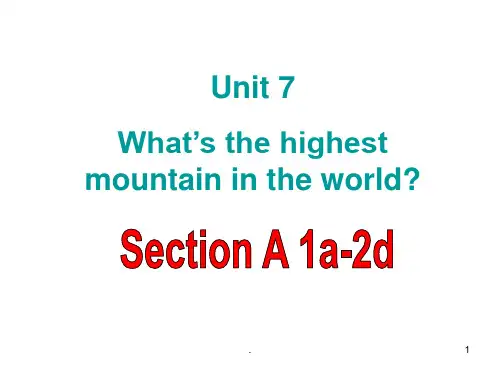
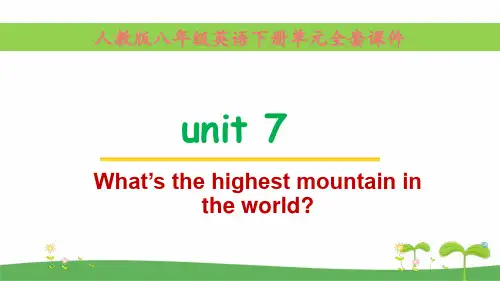
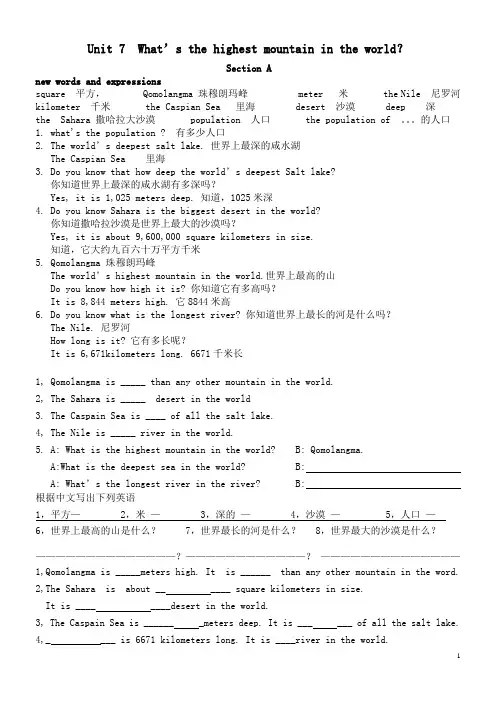
Unit 7 What’s the highest mountain in the world?Section Anew words and expressionssquare 平方, Qomolangma 珠穆朗玛峰 meter 米 the Nile 尼罗河kilometer 千米 the Caspian Sea 里海 desert 沙漠 deep 深the Sahara 撒哈拉大沙漠 population 人口 the population of 。
的人口1. what's the population ? 有多少人口2. The world’s deepest salt lake. 世界上最深的咸水湖The Caspian Sea 里海3. Do you know that how deep the wo rld’s deepest Salt lake?你知道世界上最深的咸水湖有多深吗?Yes, it is 1,025 meters deep. 知道,1025米深4. Do you know Sahara is the biggest desert in the world?你知道撒哈拉沙漠是世界上最大的沙漠吗?Yes, it is about 9,600,000 square kilometers in size.知道,它大约九百六十万平方千米5. Qomolangma 珠穆朗玛峰The world’s highest mountain in the world.世界上最高的山Do you know how high it is? 你知道它有多高吗?It is 8,844 meters high. 它8844米高6. Do you know what is the longest river? 你知道世界上最长的河是什么吗?The Nile. 尼罗河How long is it? 它有多长呢?It is 6,671kilometers long. 6671千米长1, Qomolangma is _____ than any other mountain in the world.2, The Sahara is _____ desert in the world3. The Caspain Sea is ____ of all the salt lake.4, The Nile is _____ river in the world.5. A: What is the highest mountain in the world? B: Qomolangma.A:What is the deepest sea in the world? B: A: What’s the longest river in the river? B: 根据中文写出下列英语1,平方— 2,米— 3,深的— 4,沙漠— 5,人口—6,世界上最高的山是什么? 7,世界最长的河是什么? 8,世界最大的沙漠是什么?——————————————?————————————?——————————————1,Qomolangma is _____meters high. It is ______ than any other mountain in the word. 2,The Sahara is about __ ____ square kilometers in size.It is ____ ____desert in the world.3, The Caspain Sea is ______ _meters deep. It is ___ ___ of all the salt lake. 4,_ ___ is 6671 kilometers long. It is ____river in the world.Section B New wordsAsia 亚洲wide 宽的tour 旅行tourist 旅行者wall 墙amazing 惊奇的ancient 古代的protect 保护feel free 随便(做某事) as far as I know就我所知翻译句子1.这张桌子两米长,一米宽。

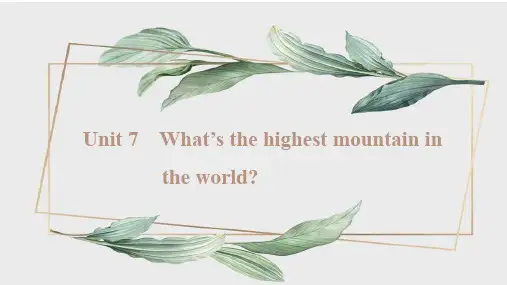
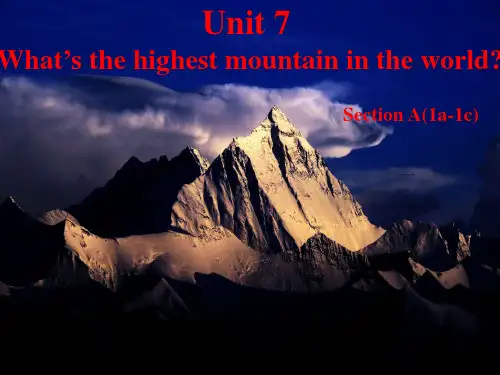
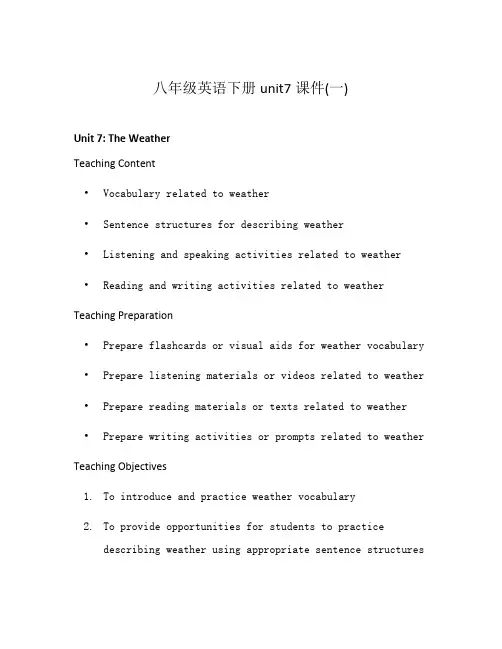
八年级英语下册unit7课件(一)Unit 7: The WeatherTeaching Content•Vocabulary related to weather•Sentence structures for describing weather•Listening and speaking activities related to weather •Reading and writing activities related to weather Teaching Preparation•Prepare flashcards or visual aids for weather vocabulary •Prepare listening materials or videos related to weather •Prepare reading materials or texts related to weather •Prepare writing activities or prompts related to weather Teaching Objectives1.To introduce and practice weather vocabulary2.To provide opportunities for students to practicedescribing weather using appropriate sentence structures3.To improve students’ listening and speaking skillsthrough weather-related activities4.To enhance students’ reading comprehension skillsthrough weather-related texts5.To develop students’ writing skills by engaging them inweather-related writing tasksDesign ExplanationThe design of this lesson aims to engage students in various activities related to weather, allowing them to actively practice and consolidate their understanding of the vocabulary and sentence structures. The lesson includes a combination of listening, speaking, reading, and writing activities to cater to different learning preferences and skills.Teaching Process1.Warm-up activity:–Show pictures of different weather conditions and ask students to describe them using the appropriatevocabulary.–Play a short video or audio clip of different weather conditions and ask students to identifythem.2.Vocabulary introduction and practice:–Present weather vocabulary using flashcards or visual aids.–Drill the pronunciation and spelling of the weather words.–Engage students in various vocabulary practice activities such as matching, fill in the blanks, orword association games.3.Sentence structure practice:–Introduce sentence structures for describingweather (e.g., “It’s sunny today,” “It’sraining heavily”).–Provide examples and model the sentence structures.–Ask students to practice forming sentences to describe different weather conditions.4.Listening and speaking activities:–Play a weather-related listening activity or video.–Ask comprehension questions to check understanding.–Engage students in speaking activities such as pair or group discussions about their favorite weatheror their experiences in different weatherconditions.5.Reading activity:–Provide students with a short passage or text about different weather conditions.–Ask students to read the text and answercomprehension questions.–Discuss the main points and key details in the text.6.Writing activity:–Assign a writing task related to weather, such as writing a weather forecast or describing amemorable weather experience.–Provide prompts or guiding questions to helpstudents structure their writing.–Collect and review students’ written work,providing feedback and suggestions for improvement.Post-lesson ReflectionThis lesson successfully engaged students in various interactive activities related to weather. The use of visual aids, listening materials, reading texts, and writing tasks provided students with different opportunities to practice and apply their understanding of weather vocabulary and sentence structures. The lesson could be further improved by incorporating more group activities and opportunities for student interaction. Additionally, providing students with real-life weather scenarios or dialogues could make the lesson more practical and relatable.Unit 7: The Weather (Continued)Teaching Content•Vocabulary related to weather•Sentence structures for describing weather•Listening and speaking activities related to weather •Reading and writing activities related to weather Teaching Preparation•Review flashcards or visual aids for weather vocabulary•Prepare additional listening materials or videos related to weather•Find more reading materials or texts related to weather •Prepare more writing activities or prompts related to weatherTeaching Objectives1.To reinforce weather vocabulary and sentence structures2.To provide extended opportunities for students topractice describing weather in speaking and writingactivities3.To further improve students’ listening and speakingskills through weather-related activities4.To deepen students’ reading comprehension skillsthrough additional weather-related texts5.To expand students’ writing skills by engaging them inmore challenging weather-related writing tasksDesign ExplanationContinuing from the previous lesson, this lesson builds upon the students’ existing knowledge of weather vocabulary and sentence structures. The focus of this lesson is toprovide additional practice and extension activities to further develop their proficiency in describing weather. The lesson includes more listening, speaking, reading, and writing activities to reinforce their understanding and skills.Teaching Process1.Warm-up activity:–Review the weather vocabulary by playing aflashcard game or a quick vocabulary quiz.–Ask students to describe the weather conditions outside the classroom at that moment.2.Vocabulary and sentence structure reinforcement:–Review the sentence structures for describing weather.–Provide additional examples and ask students to create their own sentences using different weathervocabulary.3.Listening and speaking activities:–Play a weather-related dialogue or conversation.–Ask comprehension questions and engage students in discussions about the dialogue.–Arrange pair or group activities where students role-play different weather scenarios.4.Reading activity:–Provide students with an extended reading passage about weather phenomena or climate change.–Ask students to read the text and answer more in-depth comprehension questions.–Encourage students to share and discuss their opinions on the topic.5.Writing activity:–Assign a more advanced writing task related to weather, such as writing a persuasive essay on theimpact of weather on daily life.–Provide prompts and encourage students to conduct research or gather information to support theirarguments.–Provide feedback on students’ writing and guide them in improving their critical thinking andpersuasive writing skills.Post-lesson ReflectionBuilding upon the previous lesson, this lesson successfully reinforced students’ understanding of weather vocabulary and sentence structures. The additional listening, speaking, reading, and writing activities provided opportunities for students to apply these language skills in various contexts. Students were able to engage in more in-depth discussions and express their opinions on weather-related topics. To further enhance the lesson in the future, incorporating real-life weather data, multimedia resources, or interactive online platforms relating to weather could make the learning experience more dynamic and captivating.。
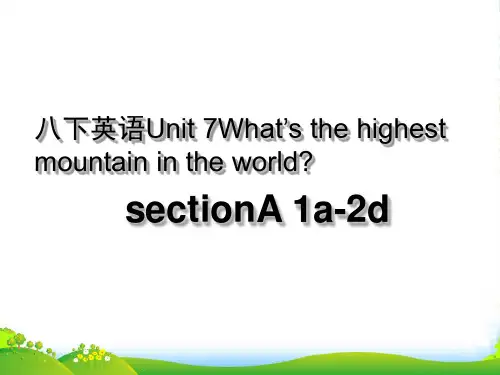
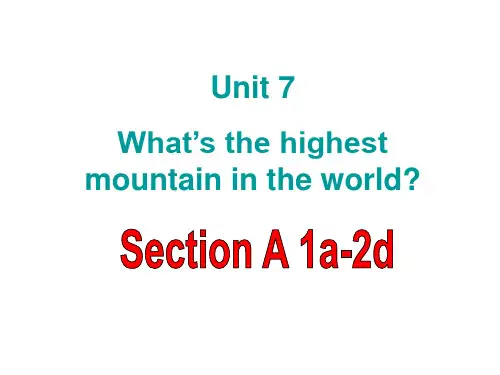

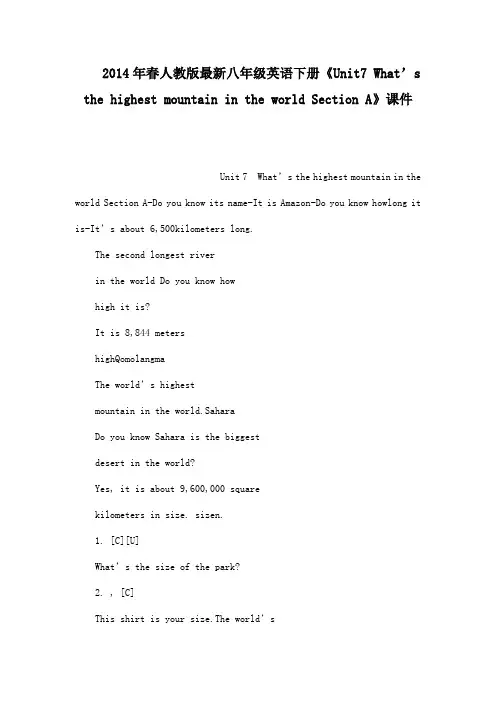
2014年春人教版最新八年级英语下册《Unit7 What’s the highest mountain in the world Section A》课件Unit 7 What’s the highest mountain in the world Section A-Do you know its name-It is Amazon-Do you know howlong it is-It’s about 6,500kilometers long.The second longest riverin the world Do you know howhigh it is?It is 8,844 metershighQomolangmaThe world’s highestmountain in the world.SaharaDo you know Sahara is the biggestdesert in the world?Yes, it is about 9,600,000 squarekilometers in size. sizen.1. [C][U]What’s the size of the park?2. , [C]This shirt is your size.The world’sdeepest salt lakeThe Caspian SeaDo you know that how deep the world’sdeepest Salt lake?Yes, it is 1,025 meters deep.The longest riverin AsiaThe Yangtze RiverDo you know that the Yangtze Riveris the longest river in Asia?Yes, it is 6,300 kilometers long. It’s 8,844 meters high. 8,844 It is … meters high long, wide… …… , ……“…… ” 1.The table is two meters longand one meter wide.2. 1500The mountain is 1,500 meters high 3. 120The building is 120 meters tall.4.The dictionary is five centimeters thick.5. 1025How deep is the lake? It’s 1,o25 meters deep. 1 Feel free to ask me anything ontoday’s Great Wall tour.feel free to do sthCan I use your bathroom?Yes, feel free.2 ancient adjMy grandmother often tells me oldancient stories.3 protect v.Sunglasses are used for protecting oureyes in the sun.4 As far as I know, there are no man-made objects as big as this.as far as I knowAs far as I know , Tom has a twinsister.5 achievement n achieve v.This is a wonderful achievement in Chinesehistory.6 southwestern adjsouthwest n.Our hometown is in the southwestern partof this city.7 thick adjThere is thick fog in the morning in this mountain area.8 Even more serious difficulties include freezing weather conditions and heavystorms.1 difficultyIf you have any difficulties, you can call mefor help.We found the house without difficulty.2 include vOur subjects include Chinese , Englishmath and so on.9 freezing adjIt is freezing outside, and put on your wintercoat.10 condition nThe piano was in good condition.11 take inLarge fish takes in small fish in the sea .12 succeed vsuccess n. successfuladj. successfully adv.I hope she will succeed soon by workinghard.13 challenge v.It is a big challenge for the girl to dohousework by herself.The boy challenged his friend to a fightafter school.14 in the face ofThey showed their couragein the face of difficulty.15 The spirit of these climbers shows usthat we should never give up trying toachieve our dreams.1 give up doing sthHe gave up smoking after he got out of thehospital.2 achieve our dreammake our dream come trueHe achieved great success in a short time.16 force nThe army was the most important force inthe country17 nature nThe beauty of nature makes people forget trouble.l o n g e s tl o n g e rh i g hp o p u l a rb i go l d e r m u c hReviewadj n longlength wide width deep depth highheight tall tallness thick thickness the height of the population ofthe length ofthe speed ofper hourman-made structuresThe mountain is 1,500 meters high.The mountain is 1,500 meters in height.The height of the mountain i s 1,500 meters.the world’s highest mountainthe highest mountain in the worldthe longest riverthe second longest riverthe biggest desertbamboo foreststhe most common animalsthe most populated placeone of the oldestcivilizationsas…asGrammar1 The Sahara is the biggest desert inthe worldthemost the" "It is a most important problem.It is a very important problem.:Tom is the tallest of his three brothers.Tom is the tallest of the three brothers.2 by far, far, much,mostly, almostThis hat is nearly / almost the biggest.a. very , muchThis is the very best.This is much the best.bAfrica is the second largest continent.3Mike is the most intelligent in his class.Mike is more intelligent than any otherstudents in his class.4 " + " " +so… as"Nothing is so easy as this.Nothing is easier than this.This is the easiest thing.1. -Which is ____ season in Beijing2003 -I think it's autumn.A. goodB. betterC. bestD. the bestseason, ,, ,the, D 2. - Which is__________ , the sun, themoon or the earth?2004-- Of course, the moon is.A. smallB. smallerC. smallestD. the smallestD"the sun, themoon or the earth", 3. The air in Beijing is getting much _____ now than a few yearsago.2005A. cleanB. cleanerC. cleanestD. the cleanestthan than。